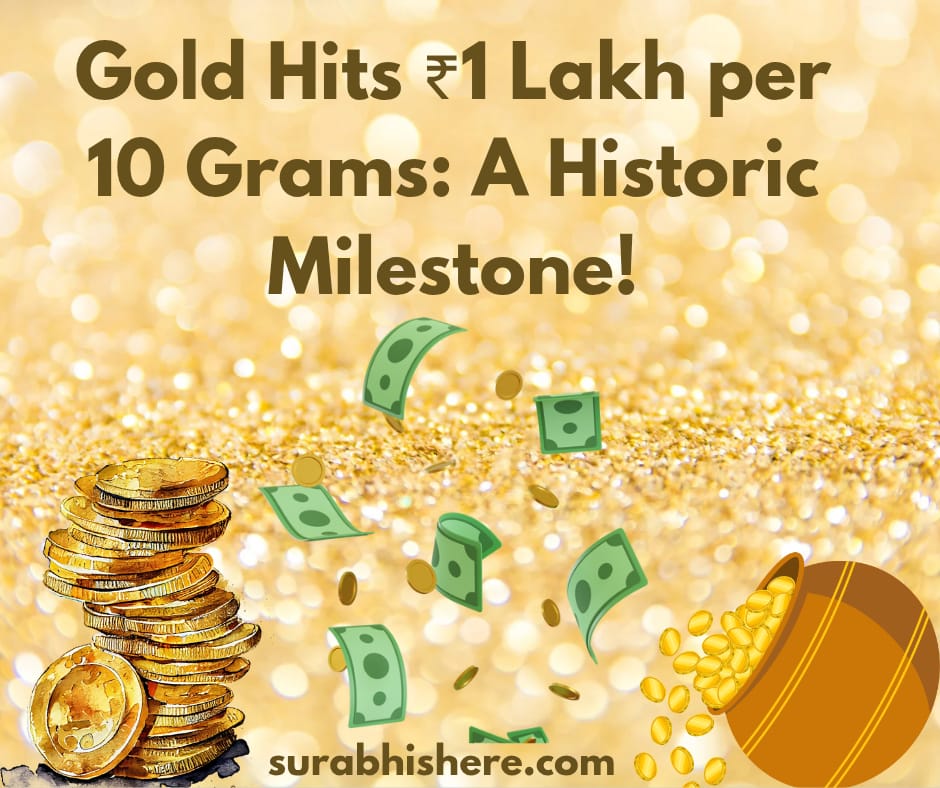
Gold has always been a precious investment in India, symbolizing wealth and financial stability. Today, a major milestone was reached as the price of 10 grams of gold crossed ₹1 lakh, making history in the Indian gold market. This surge is a result of various economic factors, and it’s essential for investors and gold enthusiasts to understand what this means for the market moving forward.
The Journey to ₹1 Lakh for 10 Grams of Gold
Over the years, gold prices in India have been gradually increasing, influenced by several global and domestic factors. Here’s a brief look at the price trend:
In 2020, during the COVID-19 pandemic, gold prices shot up to ₹56,000 per 10 grams, as investors rushed towards safe-haven assets.
From 2022 to 2024, gold maintained a steady rise, fluctuating between ₹65,000 and ₹75,000 per 10 grams, due to inflationary pressures and global economic recovery.
In 2025, the price of gold has finally crossed ₹1 lakh per 10 grams, reaching an all-time high.
Why Has Gold Crossed ₹1 Lakh?
Several key factors have contributed to the recent surge in gold prices:
- Global Economic Instability
The ongoing global recession fears and economic uncertainty have pushed investors towards gold as a reliable store of value. During periods of inflation or financial instability, people flock to gold to preserve their wealth.
- Weakening of the Indian Rupee
A depreciating Indian Rupee against the US Dollar has made gold more expensive in the domestic market, causing prices to rise sharply.
- Rising Demand for Gold
Demand for gold in India and China remains high, driven by cultural significance, wedding seasons, and economic uncertainties. This sustained demand has contributed to the price hike.
- Central Bank Gold Reserves
Central banks across the globe, including India, have been buying large quantities of gold in recent years to bolster their reserves. This institutional demand has further driven up gold prices.
- Geopolitical Tensions
Geopolitical instability, such as conflicts and tensions in different regions, often triggers increased demand for gold as a hedge against uncertainty.
What Does This Mean for Gold Investors?
For Current Gold Investors: If you’ve invested in gold in recent years, this price surge likely means significant capital gains. You might want to consider booking profits or diversifying your portfolio.
For New Gold Buyers: While gold remains a strong asset, purchasing it at ₹1 lakh for 10 grams requires careful consideration. If you’re buying for long-term wealth preservation, gold continues to be a safe option. However, it’s important to consider market conditions and potential price corrections before making a purchase.
For Jewelry Buyers: The price rise means higher jewelry costs, but gold jewelry remains a popular choice for investments and gifting, especially during auspicious seasons like weddings and festivals.
Can Gold Prices Go Higher?
While crossing ₹1 lakh per 10 grams is a significant milestone, the future of gold prices will depend on several factors:
Continued Global Economic Strain: If global uncertainty continues, there is a possibility that gold prices could continue to rise.
Monetary Policies: Central banks’ decisions, especially regarding interest rates and inflation control, can have a direct impact on gold prices.
Supply and Demand Dynamics: If demand for gold outpaces supply, prices may rise further. However, any stabilization in demand could bring corrections.
Conclusion: Gold’s Timeless Value
The crossing of ₹1 lakh for 10 grams of gold is a historic moment for the Indian gold market. Despite fluctuations, gold remains a timeless investment and a reliable asset during economic volatility.
Whether you are a long-term investor, a buyer of gold for its cultural value, or someone simply interested in the gold market, today’s price shift is an important marker. Staying informed about global economic trends and understanding market signals can help you make the right decisions when it comes to investing in gold.
